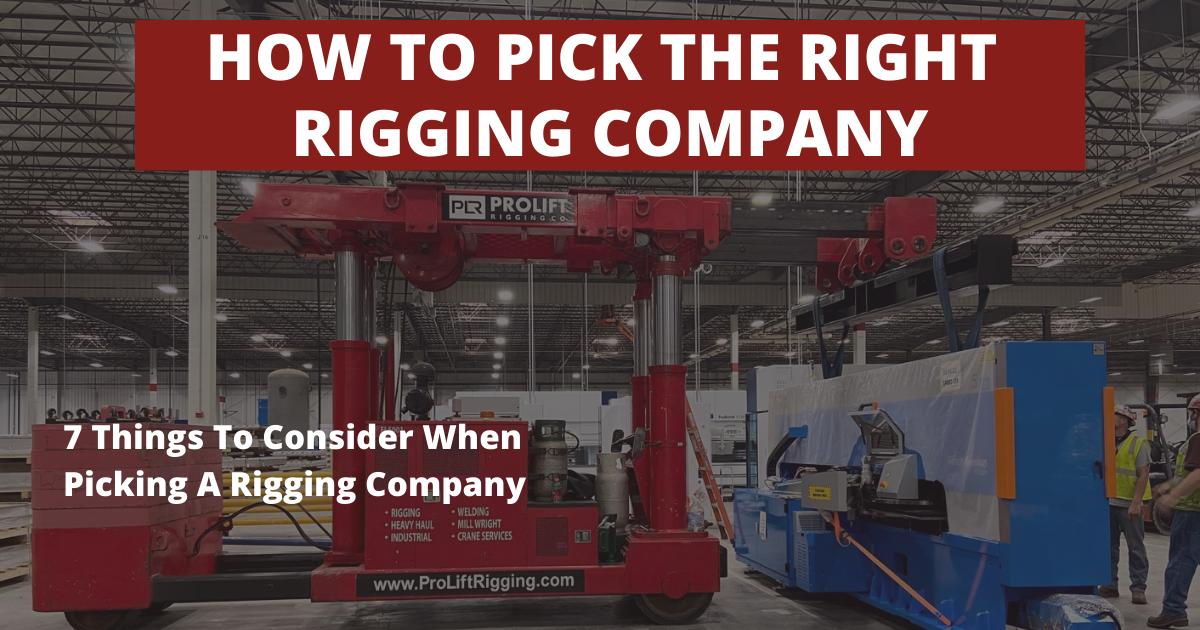How To Pick The Right Rigging Company

7 Things to Consider When Picking a Rigging Company
When a project requires lifting and moving heavy machinery and/or equipment, there are quite a few things to consider. You must first determine if the job is something you can do yourself, or if you should hire someone else to do it. Click here for a great article to help you answer that question. But for now, let’s assume you need to hire someone to do this for you. So, where do you start? Consider these 7 things when looking for the right rigging company:
1. Credible
You can establish your rigging partners’ credibility by reviewing their project resume and discussing their performance with referred customers. Consider asking if they have done anything like your project in the past. A reliable rigging company should be able to discuss their safety philosophy and systems, their safety record, and talk about how they manage physical and financial risks. Another thing to consider: Many General Liability policies exclude coverage for property being lifted, moved, or transported. A great rigging company will have some form of “Riggers’ Liability Coverage” to supplement their General Liability Coverage. This coverage specifically addresses financial losses resulting from the equipment being in your rigger’s care, custody and control.
2. Customer Focused
Many rigging companies are focused on utilization of their own equipment. This may create a conflict with your best interest if the rigging company is focused on implementing their tool, rather than arriving at the best rigging method. “Best” should be defined as the method that has the lowest impact to your facilities and operation (interference removal, ground loading, personnel safety, minimized downtime). The customer focused rigging company will start with these variables and work towards selecting a method that meets your goals rather than their goals.
3. Qualified
In 2010, the OSHA C-DAC rule was put into effect, which greatly improved the safety standards of crane and rigging companies. This requires them to follow a variety of rules such as using synthetic slings in accordance to manufacturer’s instructions, assessing the ground conditions, qualifications and certifications for lift directors, crane assembly directors, equipment operators, signal persons and more. A great question for a potential rigging partner would be, “Does your team have the necessary training and qualifications to execute this project?” You can read the full ruling here.
4. Curious
The questions a rigging company asks can be a great indicator of whether they are the group you want to trust with your project. There are many details that need to be uncovered when moving heavy equipment. Are they committed to discovering all these details to make sure they get the job done right? Some examples of good questions they may ask you are:
- Will production continue while work is being performed?
- Are there critical systems that will not be powered down or disabled during the project execution?
- How much clearance space is there around the equipment that needs to be moved?
- If there are interferences in the proposed load path, what interferences cannot be removed?
- How did you determine the weight of the equipment?
5. Communication & Responsiveness
Communication is key, especially when there is much at stake with your project. You need a partner that is committed to the level of communication you deserve. Do they help guide you through planning and coordination details? Do they uncover risks that you did not consider? Do they seek clarity on roles and responsibilities? Do they get back to you in a timely manner, or do they leave you wondering if they ever got your email? You need answers and responses quickly, so find a group that will commit to this. Pay attention to this, especially during the first few conversations with the companies you engage.
6. Problem solving
Every project is unique and comes with unique challenges. It’s important to know how your rigging partner handles curveballs that tend to arise during the project. Ask about this upfront. You may ask questions like, “What happens if the project takes longer than originally planned?” Another good question is, “What if this takes more people or equipment than we thought at first?” A good rigging partner will have recommendations on mitigating these hiccups if/when they might occur during the project.
7. Budget
Most people tend to start with this consideration. While the cost of the project is extremely important, looking for the cheapest option is not necessarily the best value. You may pay less for the rigging scope but create more costly downtime or interference removal and repair. Before considering the budget, you’ll want to first determine what project success looks like. At a minimum, that entails the completion timeframe, risk mitigation, change order prevention, etc. A competitive project proposal should address these critical factors that determine the overall budget. Low cost providers may exclude these factors, which could result in significant unforeseen costs upon the completion of the project. You may also want to consider the cost of your project being delayed or equipment getting damaged. What would happen if your project extends an extra week? What would the financial impact be on your operation if delays occur?
This is certainly not an exhaustive list of considerations when choosing a rigging partner. Hopefully, it serves as a starting point. If you would like help thinking through this or making a selection, feel free to reach out to me at nharper@proliftrigging.com. Are there any other important considerations that I didn’t include in this list? Shoot me an e-mail with your feedback. I’d love to hear from you!